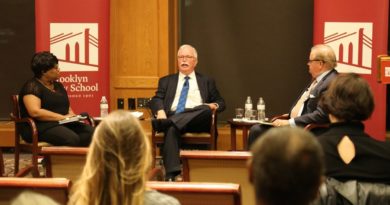Assisted Reproduction in a Post-Dobbs US
By Chloe Reichel and Seema Mohapatra
Assisted reproductive technologies (ART) such as in-vitro fertilization (IVF) face an uncertain future as anti-abortion policymakers and advocates work to restrict access to reproductive care post-Dobbs.
Until last summer, modern ART had been performed in the United States with the Constitutional protection for abortion care in the background. After Dobbs, fertility doctors and patients have begun to realize that strict abortion laws and policies affect not only those who do not wish to continue a pregnancy, but also people who very much desire to have a child.
In Dobbs, Justice Alito noted that abortion was different from other issues because it involves potential life and was not in the “history and tradition” of the United States. This language is potentially troublesome for ART. Like abortion, IVF and many forms of ART similarly could be considered not in the nation’s “history and tradition.” Like abortion, they are not mentioned in the Constitution.
Even more concerning for ART is the potential for recognition of fetal personhood. This is not a theoretical concern. In Dobbs, Justice Alito notes that the majority opinion “is not based on any view about when a State should regard prenatal life as having rights or legally cognizable interests.” So, states are free to decide on fetal personhood, which would have significant impacts on IVF and assisted reproduction.
Lower courts are already off to the races attempting to ascribe personhood to fetuses. In one recent federal district court opinion, Alliance for Hippocratic Medicine v. FDA, Judge Matthew Kacsmaryk uses the words “unborn human” and “unborn child” throughout the opinion to describe a fetus. If fetuses are given personhood status under the law, destroying them would be akin to murder. Fetal personhood would lead to a nationwide abortion ban and forced pregnancies, an end to research involving embryonic stem cells, and the prohibition of common practices used in ART, such as the discarding of embryos.
Historically, the ART community has enjoyed a deregulatory environment, especially compared with abortion care. Yet, practices in ART such as selective reduction would meet the definition of abortion in many states. Either ART will be newly subject to harsh restrictions, or it will be carved out, and thus further perpetuate inequality. In this latter case, those accessing ART, who are mostly white and wealthy, will skirt civil and criminal penalties, as well as the risks to health and well-being posed by abortion restrictions, while those seeking abortion care, who are, due to structural racism, disproportionately people of color, will face the full force of these harms.
There are myriad other concerns related to assisted reproduction post-Dobbs. For example, surrogacy, another popular form of ART, also stands to be affected. Often, surrogacy contracts state that a surrogate must have an abortion if there are unplanned complications or fetal anomalies found during pregnancy. Depending upon the state law, such clauses may no longer be allowable.
In light of this changing landscape, we asked other experts in law and medicine to reflect on pressing issues at the intersection of ART and current legal debates, such as potential implications of fetal personhood legislation, the future of IVF post-Dobbs, divergent state approaches to sperm and egg donor anonymity, workplace policies supporting access to fertility preservation. Their responses comprise this symposium. Over the coming weeks, we will publish contributions from:
- Valarie Blake and Elizabeth McCuskey on the “infertility shift” – a term they use to describe individuals taking jobs (including secondary employment) for the express purpose of securing insurance that covers infertility care. This phenomenon stems from the fact that employer plans are not required by federal law to provide coverage of infertility care, and points to the need for sweeping insurance reform.
- Naomi Cahn and Sonia Suter on informal (“DIY”) sperm donation, which they predict will increase in light of increasing barriers to fertility care post-Dobb Through their intersectional analysis, Cahn and Suter highlight concerns as well as opportunities associated with this unregulated practice.
- Glenn Cohen on rights claims associated with uterus transplantation. Surrogates and in-vitro fertilization can help people without uteruses become legal and/or genetic parents – but are uterus transplants satisfying some other right, namely, the right to experience pregnancy?
- Judith Daar on the future of IVF in a post-Dobbs U.S. Daar explains how regulations protecting embryos could potentially restrict IVF, focusing on issues around embryo discard, cryopreservation, preimplantation genetic testing, and selective reduction .
- Dov Fox and Gerard Letterie on an ironic result of “pro-life” lobbying for fetal personhood – fewer babies being born. If embryos are “persons,” then procedures like in vitro fertilization are likely to face significant restrictions and lower chances of success.
- Courtney Joslin on the recent regulations around fertility treatment, such as those targeting physician misconduct, and those preventing gamete donor anonymity. Joslin explains how these laws could threaten family autonomy and recognition, for example, by granting legal parentage to a sperm donor rather than an intended parent.
- Yvette Lindgren on the dangers abortion bans pose to all reproductive health care. Doctors may refuse or delay necessary care to patients seeking care for ectopic pregnancies, miscarriages, or high-risk pregnancies in the face of potential criminal penalties.
- Kimberly Mutcherson on racial disparities and reproductive justice – which spans not just the right to abortion, but also the right to access fertility treatment – in the wake of Dobbs. In addition to her call for coalition building, Mutcherson suggests holding so-called “pro-life” legislators’ feet to the fire: where is their support of fertility treatment?
- Scott Schweikart on the trade-offs many medical professionals face when balancing their lengthy training with the desire to start a family. In response to this dilemma, the American Medical Association, the oldest and largest professional organization of physicians in the U.S., recently passed a policy in support of trainees’ access to ART.
We look forward to sharing these wide-ranging perspectives in the days ahead.
Seema Mohapatra is the MD Anderson Foundation Endowed Professor in Health Law and Professor of Law at SMU Dedman School of Law.






